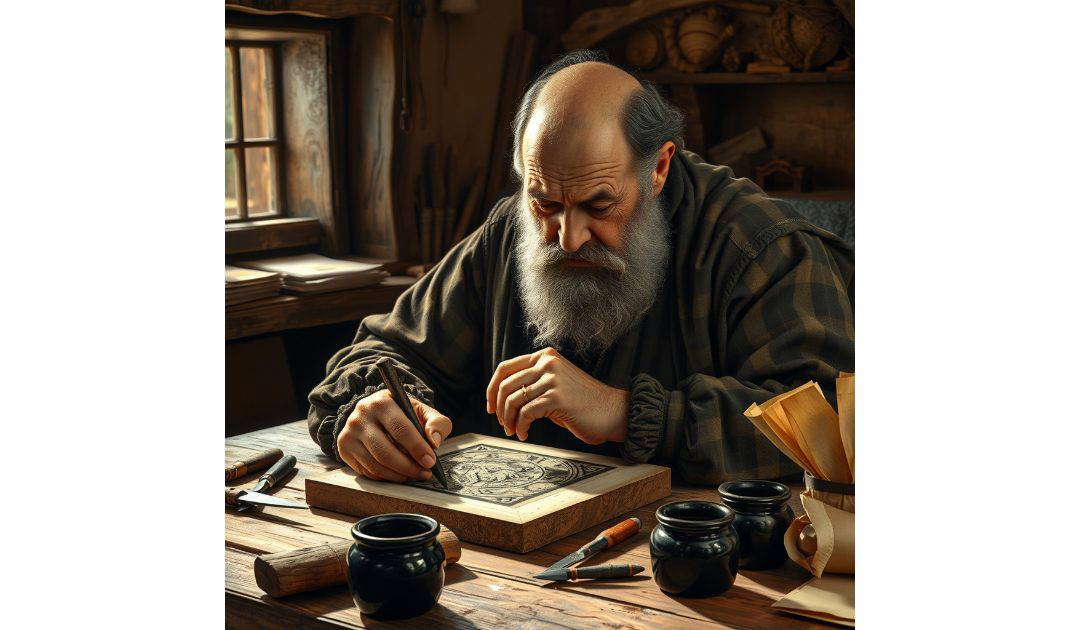Albrecht Dürer was born on the 21st of May, 1471, in Nuremberg, Germany. His name is synonymous with innovation and mastery in the realms of art and printmaking. He was a towering figure in the Northern Renaissance. His life and work bridged the gap between the medieval and modern worlds, influencing countless artists and leaving a legacy that endures to this day. Dürer’s career flourished at a time of great change and discovery, and his contributions to art and science continue to be celebrated worldwide.
Dürer was born into a family of goldsmiths, and he initially trained as such under his father’s tutelage. However, he soon displayed a natural talent for drawing, and his father arranged for him to apprentice under the painter Michael Wohlgemuth. It was here that Dürer honed his skills in woodcut printmaking, a medium that would later become one of his trademarks.
During his early years, Dürer travelled extensively, visiting the artistic hubs of Basel, Strasbourg, and Venice. These journeys exposed him to various styles and techniques, which he adeptly incorporated into his own work. His exposure to the works of Italian masters such as Leonardo da Vinci and Giovanni Bellini significantly influenced his artistic development, inspiring him to blend Northern European detail with Italian proportion and perspective.
Dürer’s oeuvre is vast and varied, encompassing paintings, drawings, prints, and theoretical writings. Perhaps his most famous work is “Melencolia I,” an enigmatic engraving that remains a subject of fascination and interpretation to this day. In this piece, Dürer explores the theme of melancholy, personifying it as a brooding angel surrounded by symbols of knowledge and creativity.
His other notable works include the “Four Horsemen of the Apocalypse,” a dynamic woodcut that forms part of his “Apocalypse” series, and the “Adoration of the Trinity,” a complex altarpiece that demonstrates his mastery of composition and colour. Dürer’s self-portraits also deserve mention. His 1500 self-portrait, in which he depicts himself in a Christ-like manner, is particularly striking for its portrayal of the artist as a divine creator.
Dürer’s contributions to the field of printmaking cannot be overstated. He revolutionised the medium by elevating it to an art form as significant as painting or sculpture. His engravings and woodcuts were widely disseminated across Europe, spreading his influence far and wide and establishing his reputation as one of the foremost artists of his time.
In addition to his artistic endeavours, Dürer was deeply interested in the scientific principles of measurement and perspective. His treatise “Underweysung der Messung” (Instruction in Measurement) showcases his profound understanding of geometry, proportion, and perspective, offering meticulous instructions for artists. This work, among others, exemplifies the Renaissance ideal of the artist as a polymath, adept in both the sciences and the arts.
Dürer’s fascination with the natural world is evident in his studies of flora and fauna, such as his famous “Rhinoceros” woodcut and his exquisite watercolour, “Young Hare.” These works reveal his keen observational skills and his ability to capture the beauty and intricacy of nature with unparalleled precision.
Albrecht Dürer’s impact on the art world is immeasurable. His innovations in printmaking and his synthesis of different artistic styles paved the way for future generations of artists. Figures such as Rembrandt and even modern artists have drawn inspiration from Dürer’s work, testifying to his enduring relevance.

